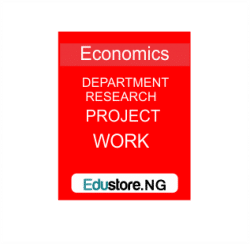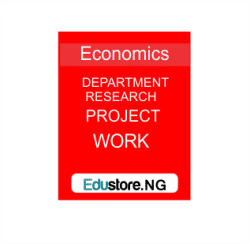Effect of Capital Structure on Firm Performance Case Study of Nestle Nigeria Plc
Abstract
This study was on effect of capital structure on firm performance case study of Nestle Nigeria Plc. Three objectives were raised which included: To examine the current capital structure of Nestle Nigeria Plc, including its debt-to-equity ratio, leverage ratio, and other financial indicators, to analyze the financial performance of Nestle Nigeria Plc in the last five years, using key financial indicators such as return on equity (ROE), return on assets (ROA), and net profit margin and to determine the relationship between capital structure and financial performance, and to identify the factors that influence this relationship. A total of 77 responses were received and validated from the enrolled participants where all respondents were drawn from Nestle Nigeria Plc. Hypothesis was tested using Chi-Square statistical tool (SPSS).
Chapter one
Introduction
Background of the study
Capital structure refers to the combination of debt and equity used by a company to finance its operations and investments. The effect of capital structure on firm performance has been a subject of debate among economists and financial analysts for many years. Some argue that having a higher proportion of debt in the capital structure can increase the risk of financial distress, while others suggest that it can improve financial performance through tax benefits and increased leverage.Majumdar and Chhibber (1999)
The relationship between capital structure and firm performance can be analyzed using various financial ratios such as return on equity (ROE), return on assets (ROA), earnings per share (EPS), and debt-to-equity ratio (D/E). In general, a company with a high level of debt in its capital structure is said to be highly leveraged. High leverage can lead to higher financial risk, as the company must meet the interest payments on its debt even in times of economic uncertainty or downturns.(Brigham E, 2004)
On the other hand, a higher level of leverage can also result in higher returns on equity, as the company can use the borrowed funds to invest in profitable opportunities. Debt can also provide tax advantages, as interest payments are tax-deductible, reducing the company’s tax liability. Therefore, a company with a higher proportion of debt in its capital structure may have a higher ROE compared to a company with a lower level of debt.(Pratomo, 2006)
However, the effect of capital structure on firm performance can vary depending on various factors such as the industry, economic conditions, and the company’s management. In industries with stable cash flows, such as utilities or telecommunication, high leverage may be more acceptable, as these industries have predictable cash flows that can support the interest payments on the debt. In contrast, in industries with volatile cash flows, such as technology or biotech, high leverage may not be feasible, as the company may face financial distress if it cannot meet the interest payments on the debt.(Leon, 2013)
In addition, the company’s management plays a crucial role in determining the optimal capital structure. The management should consider the company’s growth prospects, cash flows, and profitability before deciding on the appropriate level of debt. Too much debt can lead to financial distress, while too little debt can limit the company’s growth potential.
The effect of capital structure on firm performance is a complex issue that requires careful consideration of various factors. While high leverage can lead to higher returns on equity and tax benefits, it also increases the risk of financial distress. Therefore, companies should analyze their financial position, industry conditions, and management capabilities before determining the optimal capital structure.
Statement of the problem
The capital structure of a firm plays a critical role in its performance, as it affects the ability of the company to meet its financial obligations and maintain sustainable growth. Nestle Nigeria Plc, a leading food and beverage company in Nigeria, has been experiencing fluctuations in its financial performance in recent years. There is a need to investigate the effect of the capital structure on the firm’s performance, with a particular focus on identifying the optimal capital structure that would enhance the company’s performance.
What is the effect of capital structure on the performance of Nestle Nigeria Plc, and what is the optimal capital structure that would enhance the company’s performance?
Objective of the study
The objectives of the study are;
- To examine the current capital structure of Nestle Nigeria Plc, including its debt-to-equity ratio, leverage ratio, and other financial indicators.
- To analyze the financial performance of Nestle Nigeria Plc in the last five years, using key financial indicators such as return on equity (ROE), return on assets (ROA), and net profit margin.
- To determine the relationship between capital structure and financial performance, and to identify the factors that influence this relationship.
Research Hypotheses
H1:there is no current capital structure of Nestle Nigeria Plc, including its debt-to-equity ratio, leverage ratio, and other financial indicators.
H2: there is no financial performance of Nestle Nigeria Plc in the last five years, using key financial indicators such as return on equity (ROE), return on assets (ROA), and net profit margin.
Significance of the study
The study on the effect of capital structure on firm performance is significant for several reasons. First, it contributes to the literature on capital structure and firm performance by providing empirical evidence of how the capital structure of a firm impacts its financial performance. This is important because the capital structure is a crucial decision for firms, as it affects their cost of capital, financial flexibility, and risk level.
Second, the study provides insights into the capital structure decisions of Nestle Nigeria Plc, which is one of the leading companies in Nigeria’s food and beverage industry. By examining the capital structure of Nestle Nigeria Plc and its impact on the company’s financial performance, the study can provide valuable information for managers and investors who are interested in the company.
Third, the study can also have practical implications for other companies in Nigeria’s food and beverage industry and beyond. By understanding the relationship between capital structure and firm performance, companies can make better-informed decisions about their own capital structure, which can ultimately lead to improved financial performance and greater shareholder value.
Scope of the study
The scope of the study covers effect of capital structure on firm performance . the study will be limited to of Nestle Nigeria Plc in Lagos
Definition of terms
Capital structure: Capital structure refers to the specific mix of debt and equity used to finance a company’s assets and operations. From a corporate perspective, equity represents a more expensive, permanent source of capital with greater financial flexibility.
Firm performance: The power of a business to implement activities better rather than its competitors. Learn more in: Strategic Information Systems Planning. Firm performance can be measured either by sales growth or return on assets.
DOWNLOAD COMPLETE WORK- For Reference Only: Materials are for research, citation, and idea generation purposes and not for submission as your original final year project work.
- Avoid Plagiarism: Do not copy or submit this content as your own project. Doing so may result in academic consequences.
- Use as a Framework: This complete project research material should guide the development of your own final year project work.
- Academic Access: This platform is designed to reduce the stress of visiting school libraries by providing easy access to research materials.
- Institutional Support: Tertiary institutions encourage the review of previous academic works such as journals and theses.
- Open Education: The site is maintained through paid subscriptions to continue offering open access educational resources.




